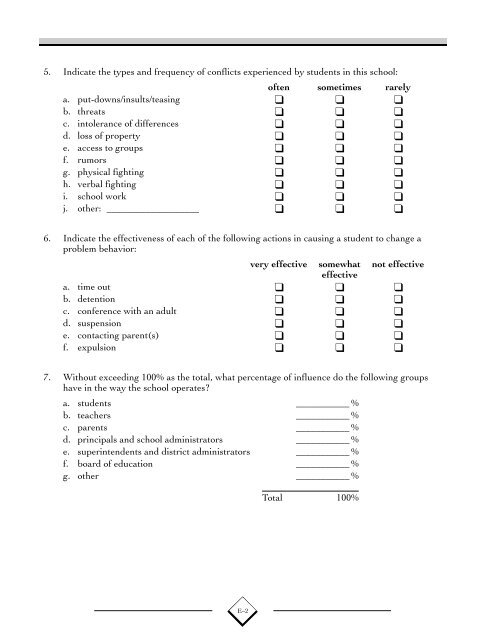Conflict Resolution Education - National Criminal Justice Reference ...
Conflict Resolution Education - National Criminal Justice Reference ...
Conflict Resolution Education - National Criminal Justice Reference ...
Create successful ePaper yourself
Turn your PDF publications into a flip-book with our unique Google optimized e-Paper software.
5. Indicate the types and frequency of conflicts experienced by students in this school:<br />
often sometimes rarely<br />
a. put-downs/insults/teasing ❑ ❑ ❑<br />
b. threats ❑ ❑ ❑<br />
c. intolerance of differences ❑ ❑ ❑<br />
d. loss of property ❑ ❑ ❑<br />
e. access to groups ❑ ❑ ❑<br />
f. rumors ❑ ❑ ❑<br />
g. physical fighting ❑ ❑ ❑<br />
h. verbal fighting ❑ ❑ ❑<br />
i. school work ❑ ❑ ❑<br />
j. other: ___________________ ❑ ❑ ❑<br />
6. Indicate the effectiveness of each of the following actions in causing a student to change a<br />
problem behavior:<br />
very effective somewhat<br />
effective<br />
not effective<br />
a. time out ❑ ❑ ❑<br />
b. detention ❑ ❑ ❑<br />
c. conference with an adult ❑ ❑ ❑<br />
d. suspension ❑ ❑ ❑<br />
e. contacting parent(s) ❑ ❑ ❑<br />
f. expulsion ❑ ❑ ❑<br />
7. Without exceeding 100% as the total, what percentage of influence do the following groups<br />
have in the way the school operates?<br />
a. students ___________ %<br />
b. teachers ___________ %<br />
c. parents ___________ %<br />
d. principals and school administrators ___________ %<br />
e. superintendents and district administrators ___________ %<br />
f. board of education ___________ %<br />
g. other ___________ %<br />
E–2<br />
Total 100%

















